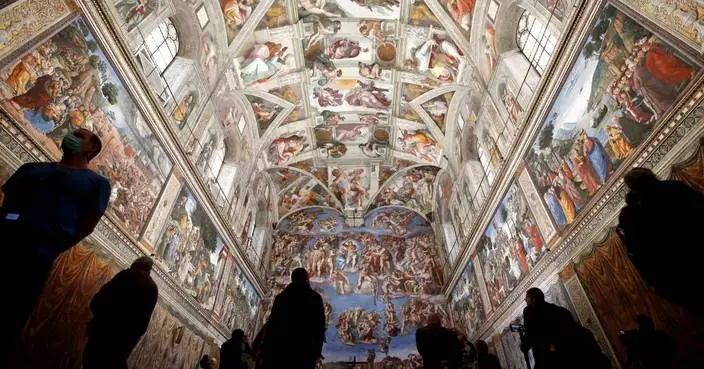TORONTO (AP) — Max Domi scored at 3:09 of overtime as the Toronto Maple Leafs survived a blown 2-0 lead to defeat the Ottawa Senators 3-2 and go up 2-0 in their first-round playoff series Tuesday night.
The winger moved into the offensive zone in the extra period and ripped his first of the post-season upstairs past Linus Ullmark.
Click to Gallery
Ottawa Senators Brady Tkachuk (7) takes a shot on net against Toronto Maple Leafs goaltender Anthony Stolarz (41) during first period of NHL playoff action in Toronto on Tuesday, April 22, 2025. (Cole Burston/The Canadian Press via AP)
Toronto Maple Leafs' Matthew Knies (23) falls on a wraparound attempt against Ottawa Senators goaltender Linus Ullmark (35) during first period NHL playoff action in Toronto on Tuesday, April 22, 2025. (Nick Iwanyshyn/The Canadian Press via AP)
Referees break up a fight between Toronto Maple Leafs' Scott Laughton (24) and Ottawa Senators' Claude Giroux (28) during first period NHL playoff action in Toronto on Tuesday, April 22, 2025. (Cole Burston/The Canadian Press via AP)
Ottawa Senators' Drake Batherson (19) and Toronto Maple Leafs' Morgan Rielly (44) collide along the boards during second period NHL playoff action in Toronto on Tuesday, April 22, 2025. (Nick Iwanyshyn/The Canadian Press via AP)
Toronto Maple Leafs fans cheer as they take on the Ottawa Senators during second period NHL playoff action in Toronto, on Tuesday, April 22, 2025. (Cole Burston/The Canadian Press via AP)
Toronto Maple Leafs' Auston Matthews (34) tips a puck toward Ottawa Senators goaltender Linus Ullmark (35) while being defended by Ottawa Senators' Artem Zub (2) during second period NHL playoff action in Toronto on Tuesday, April 22, 2025. (Cole Burston/The Canadian Press via AP)
Toronto Maple Leafs goaltender Anthony Stolarz (41) looks toward the referee after receiving an interference penalty against Ottawa Senators' Ridly Greig (71) during second period NHL playoff action in Toronto on Tuesday, April 22, 2025. (Cole Burston/The Canadian Press via AP)
Ottawa Senators' Dylan Cozens (24) takes a shot on Toronto Maple Leafs goaltender Anthony Stolarz (41) while being defended by Toronto Maple Leafs' Simon Benoit (2) during second period NHL playoff action in Toronto on Tuesday, April 22, 2025. (Cole Burston/The Canadian Press via AP)
Toronto Maple Leafs' Pontus Holmberg (29) and Ottawa Senators' Thomas Chabot (72) battle for the puck during second period NHL playoff action in Toronto, on Tuesday, April 22, 2025. (Cole Burston/The Canadian Press via AP)
Toronto Maple Leafs' Auston Matthews (34) tries to make a shot on Ottawa Senators goaltender Linus Ullmark (35) with pressure from Ottawa Senators' Thomas Chabot (72) during third period NHL playoff action in Toronto on Tuesday, April 22, 2025. (Nick Iwanyshyn/The Canadian Press via AP)
The Toronto Maple Leafs celebrate the overtime win during NHL playoff action in Toronto, on Tuesday, April 22, 2025. (Cole Burston/The Canadian Press via AP)
“Unreal,” Leafs centre John Tavares said. “Great for him, great for our team.”
Tavares, with a goal and an assist, and Morgan Rielly provided the rest of the offense for Toronto. Anthony Stolarz made 26 saves.
“Just pure jubilation,” Stolarz said of Domi’s winner that set off wild celebrations inside and outside Scotiabank Arena. “He’s a hell of a teammate in the room, and to see someone like that get rewarded, hopefully it’s the start of something big.”
Brady Tkachuk and Adam Gaudette scored for Ottawa. Ullmark stopped 18 shots.
The best-of-seven Battle of Ontario now shifts to the nation’s capital for Games 3 and 4 beginning Thursday at the Canadian Tire Centre.
The Leafs, who took Sunday’s opener 6-2, lead a post-season series 2-0 for the first time since 2002.
In the playoffs for the first time in eight years following a long rebuild, the Senators limp home looking for answers.
“We’re looking forward to getting home,” Tkachuk said. “And honestly, there’s not one ounce of panic.”
Toronto, which beat Ottawa four times in five postseason matchups in the early 2000s, is 10-0 all-time in series where the club wins the first two games at home, and has a two-game playoff edge for just the second time in 10 tries across the Auston Matthews-Mitch Marner era.
After scoring three quick-strike goals on the man advantage in Game 1 against an inexperienced and undisciplined opponent, Toronto capitalized 18 seconds into its first opportunity when Tavares sent a puck into the crease that deflected in off Ottawa defenseman Nick Jensen on the home side’s fourth shot at 8:20.
Stolarz decked Senators forward Ridly Greig, who slid into the netminder late in Game 1, at the end of an Ottawa power play in the second on a sequence that resulted in coincidental minor penalties.
The series marks the first time in NHL history two Canadian teams with U.S.-born captains — Ottawa’s Tkachuk and Toronto’s Matthews — have met in the playoffs.
Leafs head coach Craig Berube, who won the Stanley Cup with the St. Louis Blues in 2019 and has been handed the reins of an organization looking to end decades of playoff misery, was asked pregame about his initial thoughts on the Battle of Ontario.
“There’s some hatred there, for sure,” the former NHL tough guy from Alberta said with a grin. “It’s pretty good. I enjoy it.”
AP NHL: https://apnews.com/NHL
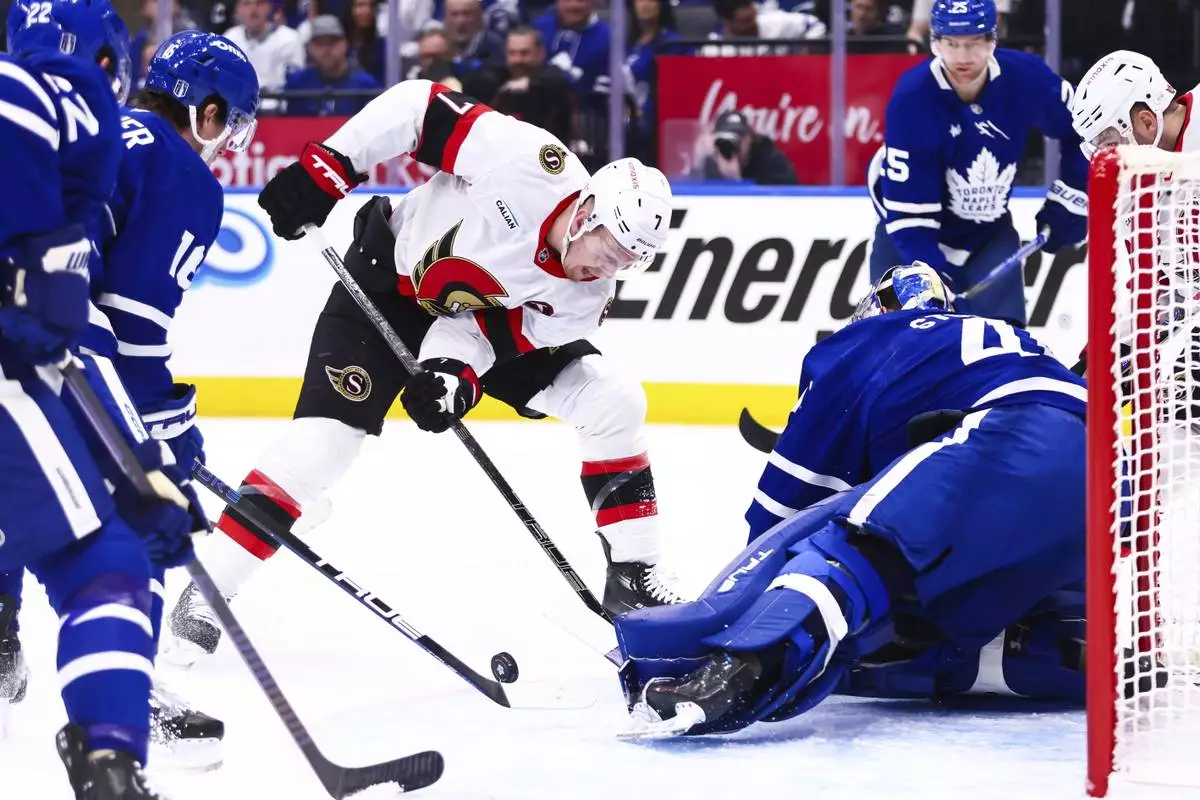
Ottawa Senators Brady Tkachuk (7) takes a shot on net against Toronto Maple Leafs goaltender Anthony Stolarz (41) during first period of NHL playoff action in Toronto on Tuesday, April 22, 2025. (Cole Burston/The Canadian Press via AP)

Toronto Maple Leafs' Matthew Knies (23) falls on a wraparound attempt against Ottawa Senators goaltender Linus Ullmark (35) during first period NHL playoff action in Toronto on Tuesday, April 22, 2025. (Nick Iwanyshyn/The Canadian Press via AP)
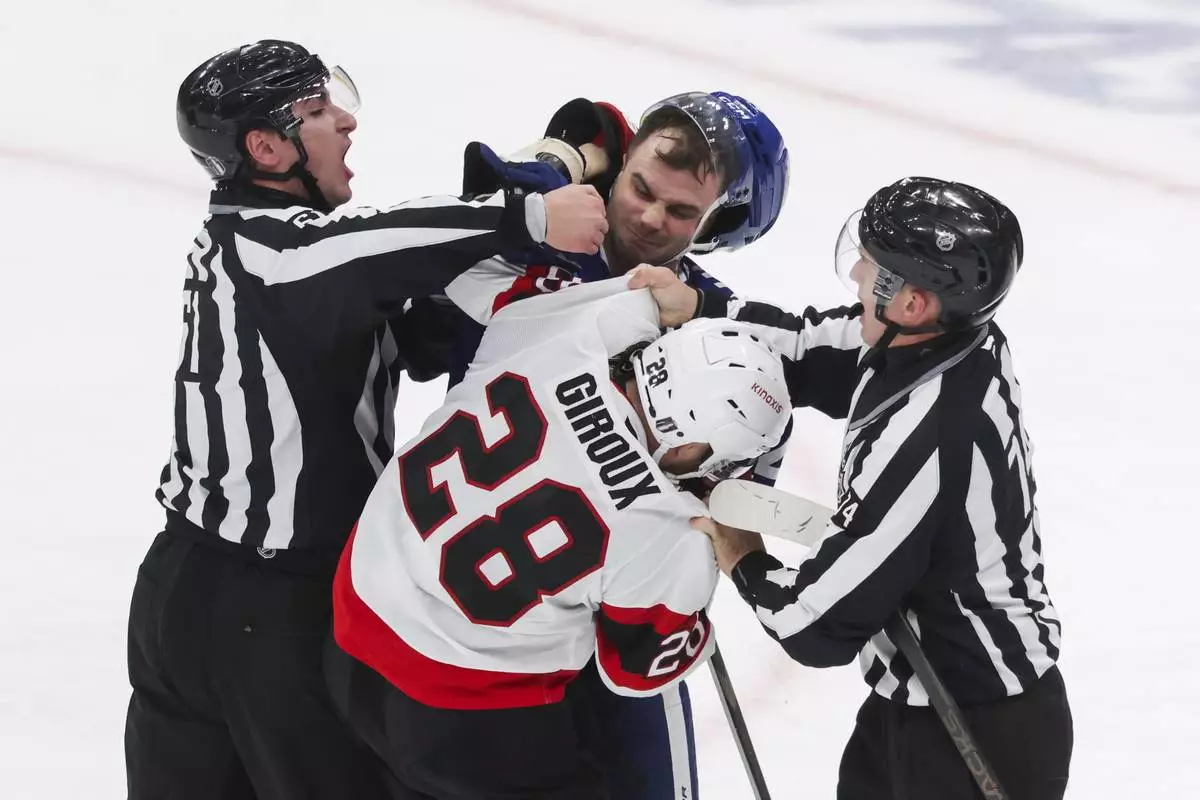
Referees break up a fight between Toronto Maple Leafs' Scott Laughton (24) and Ottawa Senators' Claude Giroux (28) during first period NHL playoff action in Toronto on Tuesday, April 22, 2025. (Cole Burston/The Canadian Press via AP)

Ottawa Senators' Drake Batherson (19) and Toronto Maple Leafs' Morgan Rielly (44) collide along the boards during second period NHL playoff action in Toronto on Tuesday, April 22, 2025. (Nick Iwanyshyn/The Canadian Press via AP)
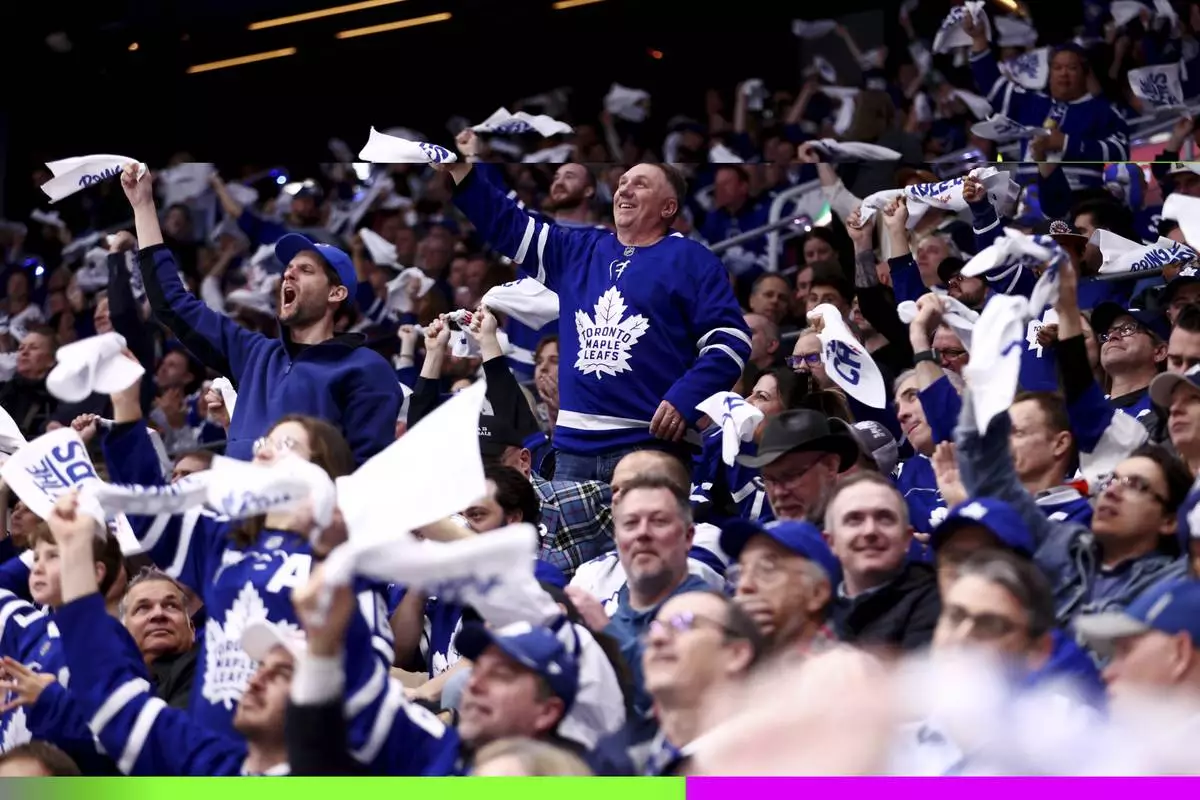
Toronto Maple Leafs fans cheer as they take on the Ottawa Senators during second period NHL playoff action in Toronto, on Tuesday, April 22, 2025. (Cole Burston/The Canadian Press via AP)

Toronto Maple Leafs' Auston Matthews (34) tips a puck toward Ottawa Senators goaltender Linus Ullmark (35) while being defended by Ottawa Senators' Artem Zub (2) during second period NHL playoff action in Toronto on Tuesday, April 22, 2025. (Cole Burston/The Canadian Press via AP)
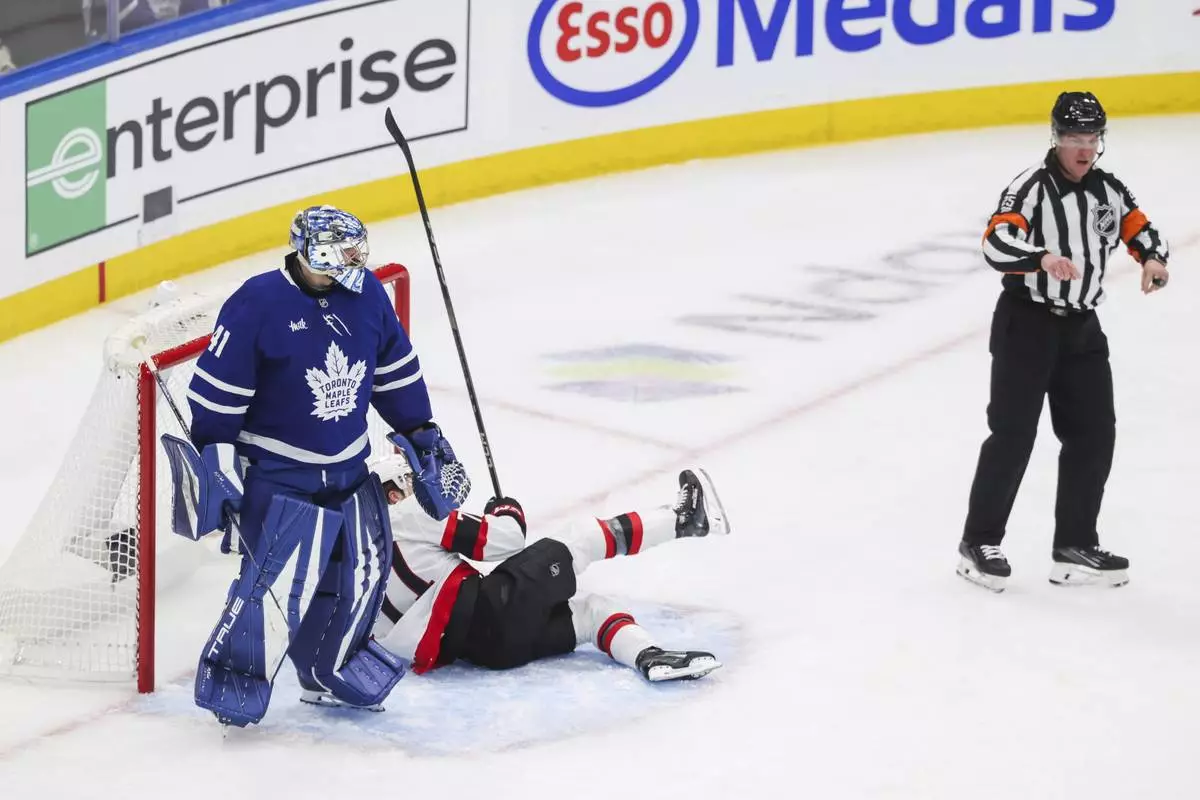
Toronto Maple Leafs goaltender Anthony Stolarz (41) looks toward the referee after receiving an interference penalty against Ottawa Senators' Ridly Greig (71) during second period NHL playoff action in Toronto on Tuesday, April 22, 2025. (Cole Burston/The Canadian Press via AP)
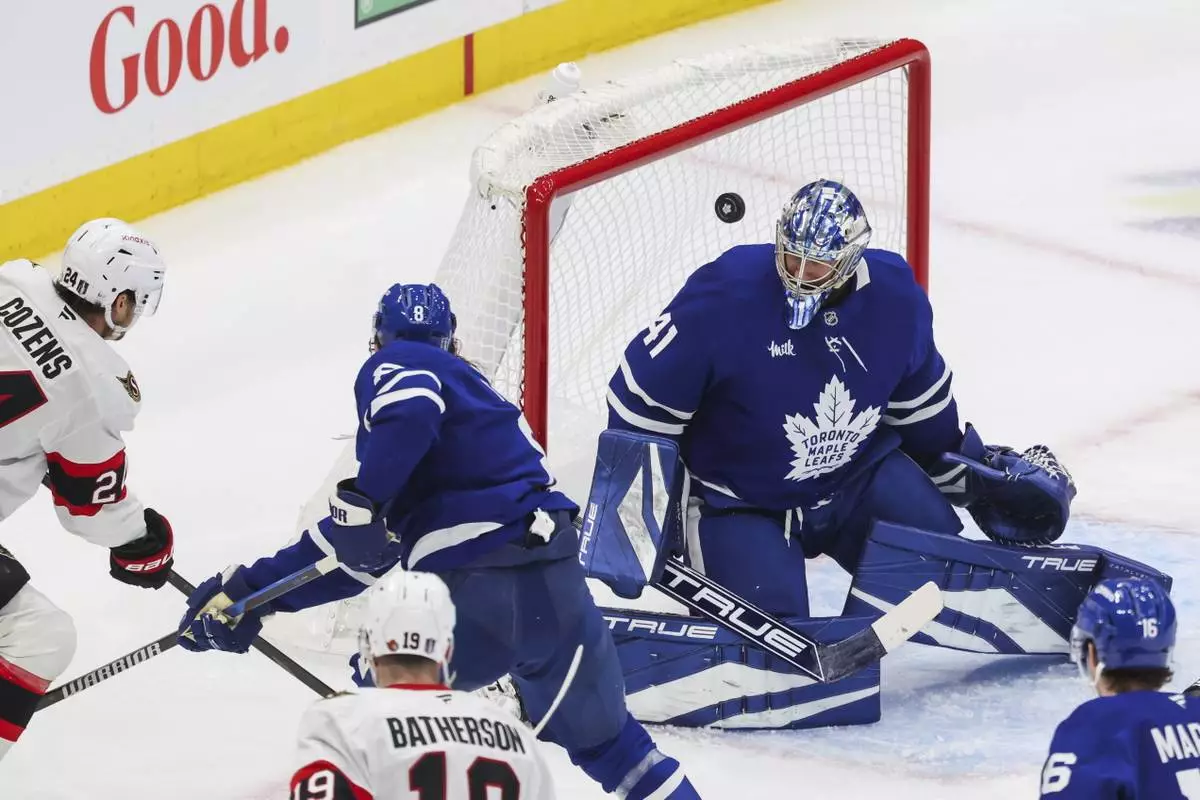
Ottawa Senators' Dylan Cozens (24) takes a shot on Toronto Maple Leafs goaltender Anthony Stolarz (41) while being defended by Toronto Maple Leafs' Simon Benoit (2) during second period NHL playoff action in Toronto on Tuesday, April 22, 2025. (Cole Burston/The Canadian Press via AP)

Toronto Maple Leafs' Pontus Holmberg (29) and Ottawa Senators' Thomas Chabot (72) battle for the puck during second period NHL playoff action in Toronto, on Tuesday, April 22, 2025. (Cole Burston/The Canadian Press via AP)
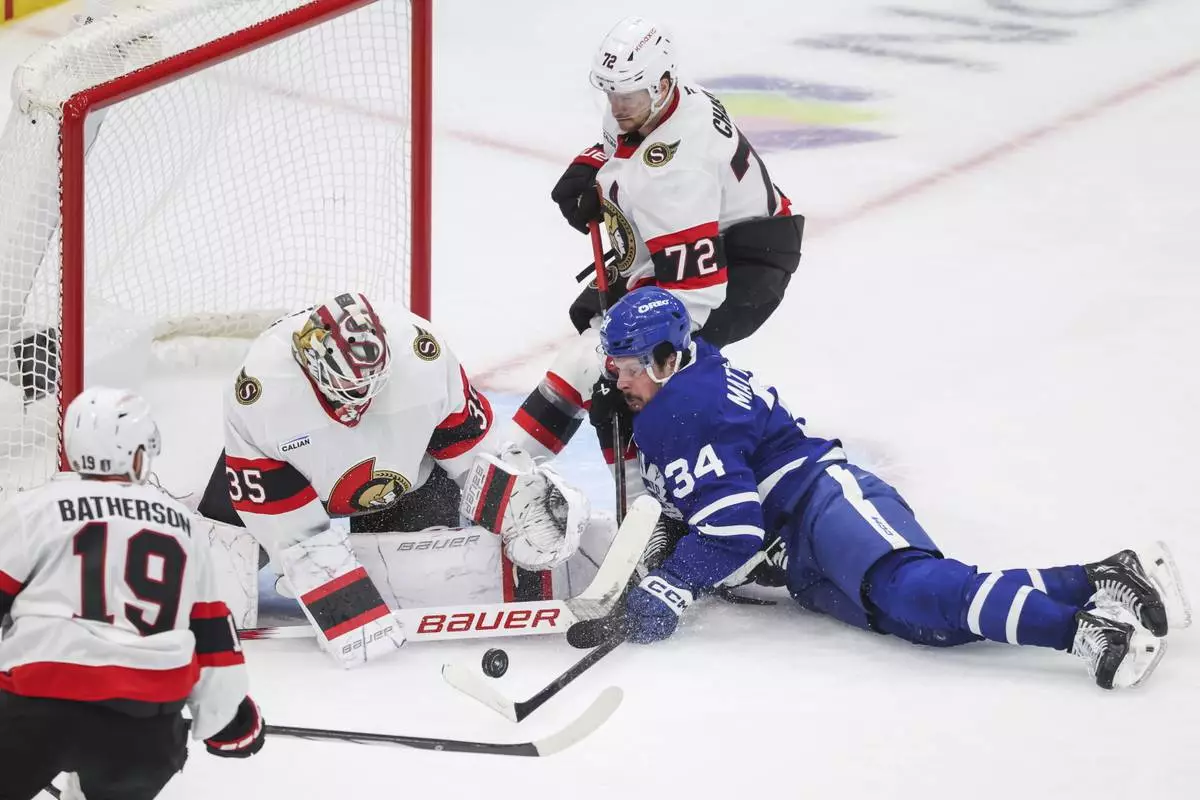
Toronto Maple Leafs' Auston Matthews (34) tries to make a shot on Ottawa Senators goaltender Linus Ullmark (35) with pressure from Ottawa Senators' Thomas Chabot (72) during third period NHL playoff action in Toronto on Tuesday, April 22, 2025. (Nick Iwanyshyn/The Canadian Press via AP)
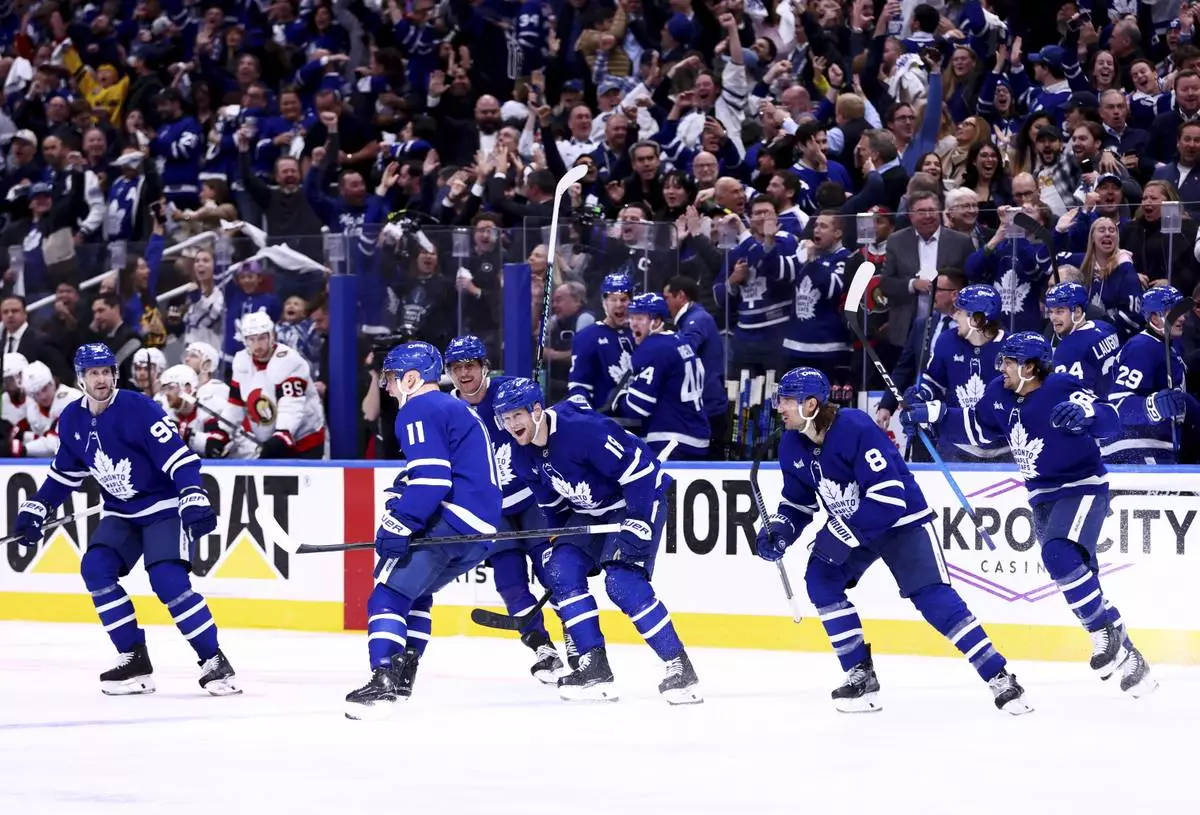
The Toronto Maple Leafs celebrate the overtime win during NHL playoff action in Toronto, on Tuesday, April 22, 2025. (Cole Burston/The Canadian Press via AP)
VATICAN CITY (AP) — “Conclave,” the movie, may have introduced movie-goers to the spectacular ritual and drama of a modern conclave, but the periodic voting to elect a new pope has been going on for centuries and created a whole genre of historical trivia.
Here are some fun facts about conclaves past, derived from historical studies including Miles Pattenden's “Electing the Pope in Early Modern Italy, 1450–1700” and interviews with experts including Elena Cangiano, an archeologist at Viterbo's Palazzo dei Papi (Palace of the Popes).
In the 13th century, it took almost three years — 1,006 days to be exact — to choose Pope Clement IV's successor, making it the longest conclave in the Catholic Church’s history. It's also where the term conclave comes from — "under lock and key," because the cardinals who were meeting in Viterbo, north of Rome, took so long the town's frustrated citizens locked them in the room.
The secret vote that elected Pope Gregory X lasted from November 1268 to September 1271. It was the first example of a papal election by “compromise,” after a long struggle between supporters of two main geopolitical medieval factions — those faithful to the papacy and those supporting the Holy Roman Empire.
Gregory X was elected only after Viterbo residents tore the roof off the building where the prelates were staying and restricted their meals to bread and water to pressure them to come to a conclusion. Hoping to avoid a repeat, Gregory X decreed in 1274 that cardinals would only get “one meal a day” if the conclave stretched beyond three days, and only “bread, water and wine” if it went beyond eight. That restriction has been dropped.
Before 1274, there were times when a pope was elected the same day as the death of his predecessor. After that, however, the church decided to wait at least 10 days before the first vote. Later that was extended to 15 days to give all cardinals time to get to Rome. The quickest conclave observing the 10-day wait rule appears to have been the 1503 election of Pope Julius II, who was elected in just a few hours, according to Vatican historian Ambrogio Piazzoni. In more recent times, Pope Francis was elected in 2013 on the fifth ballot, Benedict XVI won in 2005 on the fourth and Pope Pius XII won on the third in 1939.
The first conclave held under Michelangelo's frescoed ceiling in the Sistine Chapel was in 1492. Since 1878, the world-renowned chapel has become the venue of all conclaves. “Everything is conducive to an awareness of the presence of God, in whose sight each person will one day be judged,” St. John Paul II wrote in his 1996 document regulating the conclave, “Universi Dominici Gregis.” The cardinals sleep a short distance away in the nearby Domus Santa Marta hotel or a nearby residence.
Most conclaves were held in Rome, with some taking place outside the Vatican walls. Four were held in the Pauline Chapel of the papal residence at the Quirinale Palace, while some 30 others were held in St. John Lateran Basilica, Santa Maria Sopra Minerva or other places in Rome. On 15 occasions they took place outside Rome and the Vatican altogether, including in Viterbo, Perugia, Arezzo and Venice in Italy, and Konstanz, Germany, and Lyon, France.
Between 1378-1417, referred to by historians as the Western Schism, there were rival claimants to the title of pope. The schism produced multiple papal contenders, the so-called antipopes, splitting the Catholic Church for nearly 40 years. The most prominent antipopes during the Western Schism were Clement VII, Benedict XIII, Alexander V, and John XXIII. The schism was ultimately resolved by the Council of Constance in 1417, which led to the election of Martin V, a universally accepted pontiff.
The cloistered nature of the conclave posed another challenge for cardinals: staying healthy. Before the Domus Santa Marta guest house was built in 1996, cardinal electors slept on cots in rooms connected to the Sistine Chapel. Conclaves in the 16th and 17th centuries were described as “disgusting” and “badly smelling,” with concern about disease outbreaks, particularly in summer, according to historian Miles Pattenden. “The cardinals simply had to have a more regular and comfortable way of living because they were old men, many of them with quite advanced disease,” Pattenden wrote. The enclosed space and lack of ventilation further aggravated these issues. Some of the electors left the conclave sick, often seriously.
Initially, papal elections weren’t as secretive, but concerns about political interference soared during the longest conclave in Viterbo. Gregory X decreed that cardinal electors should be locked in seclusion, “cum clave” (with a key), until a new pope was chosen. The purpose was to create a totally secluded environment where the cardinals could focus on their task, guided by God’s will, without any political interference or distractions. Over the centuries, various popes have modified and reinforced the rules surrounding the conclave, emphasizing the importance of secrecy.
Pope John XII was just 18 when he was elected in 955. The oldest popes were Pope Celestine III (elected in 1191) and Celestine V (elected in 1294) who were both nearly 85. Benedict XVI was 78 when he was elected in 2005.
There is no requirement that a pope be a cardinal, but that has been the case for centuries. The last time a pope was elected who wasn’t a cardinal was Urban VI in 1378. He was a monk and archbishop of Bari. While the Italians have had a stranglehold on the papacy over centuries, there have been many exceptions aside from John Paul II (Polish in 1978) and Benedict XVI (German in 2005) and Francis (Argentine in 2013). Alexander VI, elected in 1492, was Spanish; Gregory III, elected in 731, was Syrian; Adrian VI, elected in 1522, was from the Netherlands.
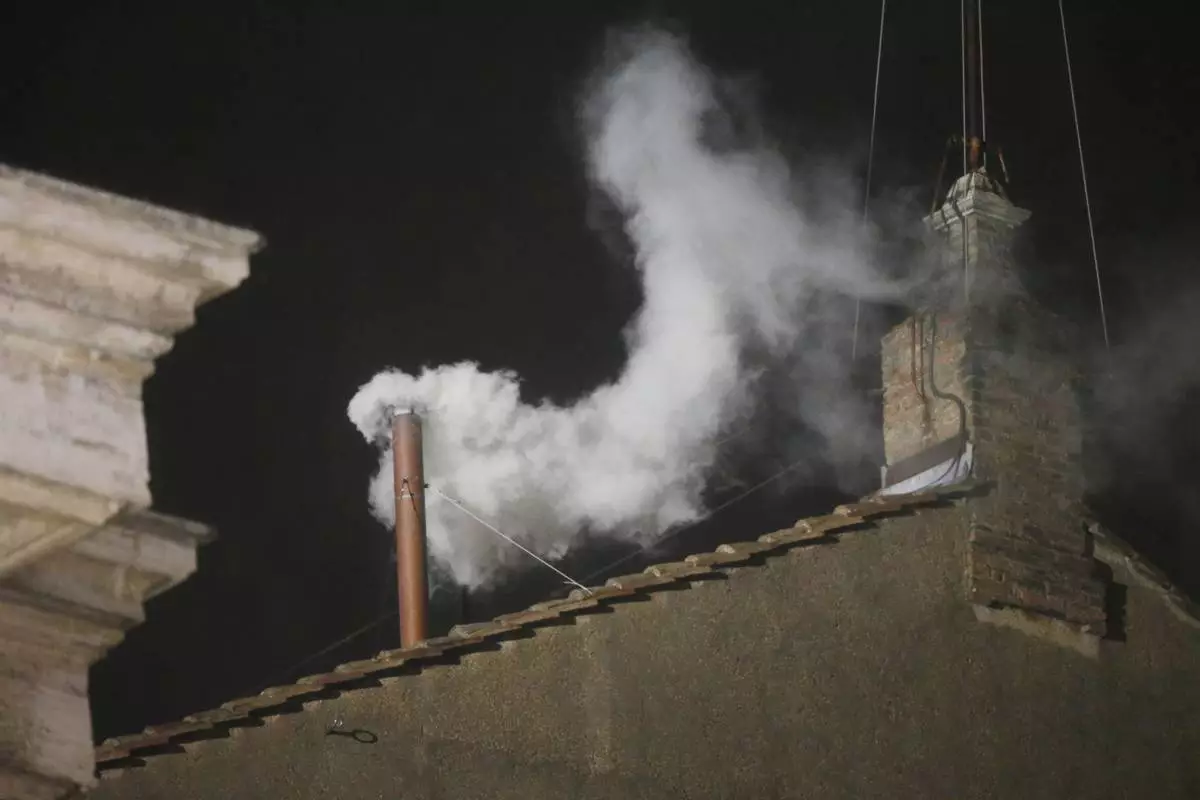
FILE - White smoke is seen billowing out from the chimney of the Sistine Chapel and announcing that a new pope has been elected on Wednesday, March 13, 2013. (AP Photo/Gregorio Borgia, File)
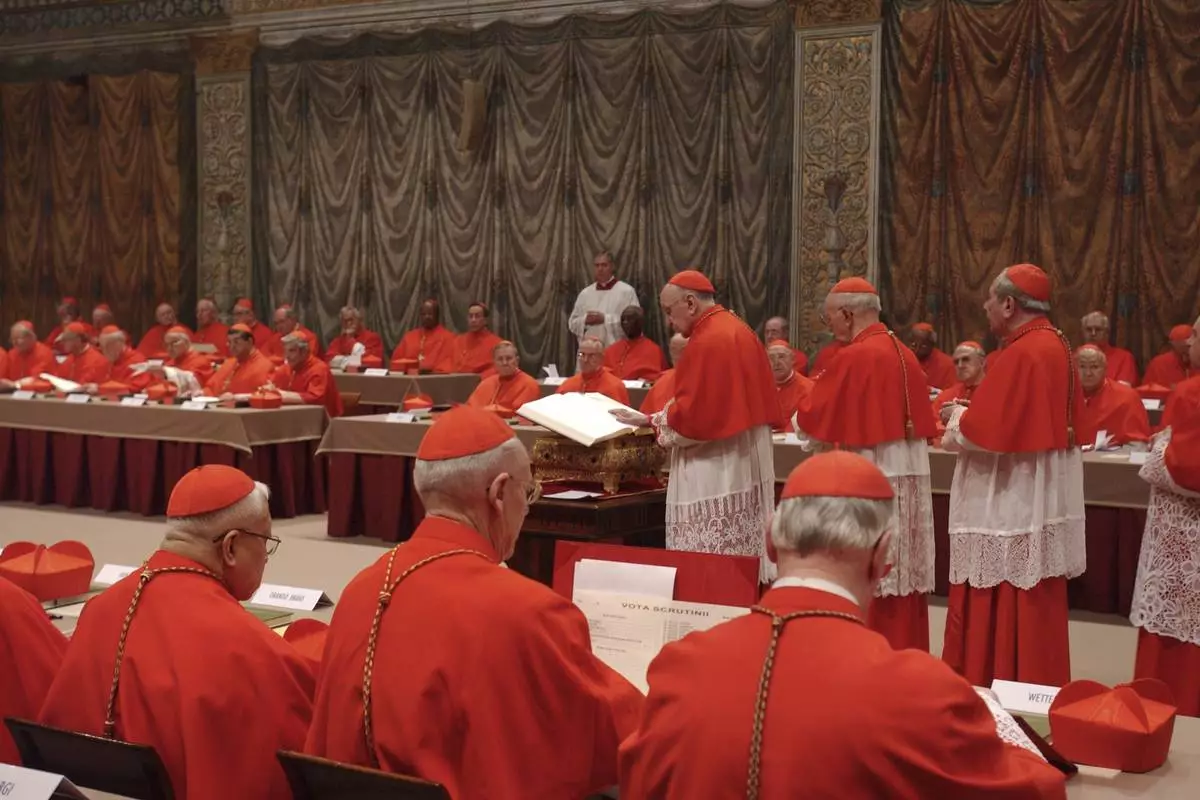
FILE - Italian Cardinal Giacomo Biffi, center, takes an oath at the beginning of the conclave to elect the next pope in the Sistine Chapel at the Vatican, Monday, April 18, 2005. (AP Photo/Osservatore Romano via AP, File)
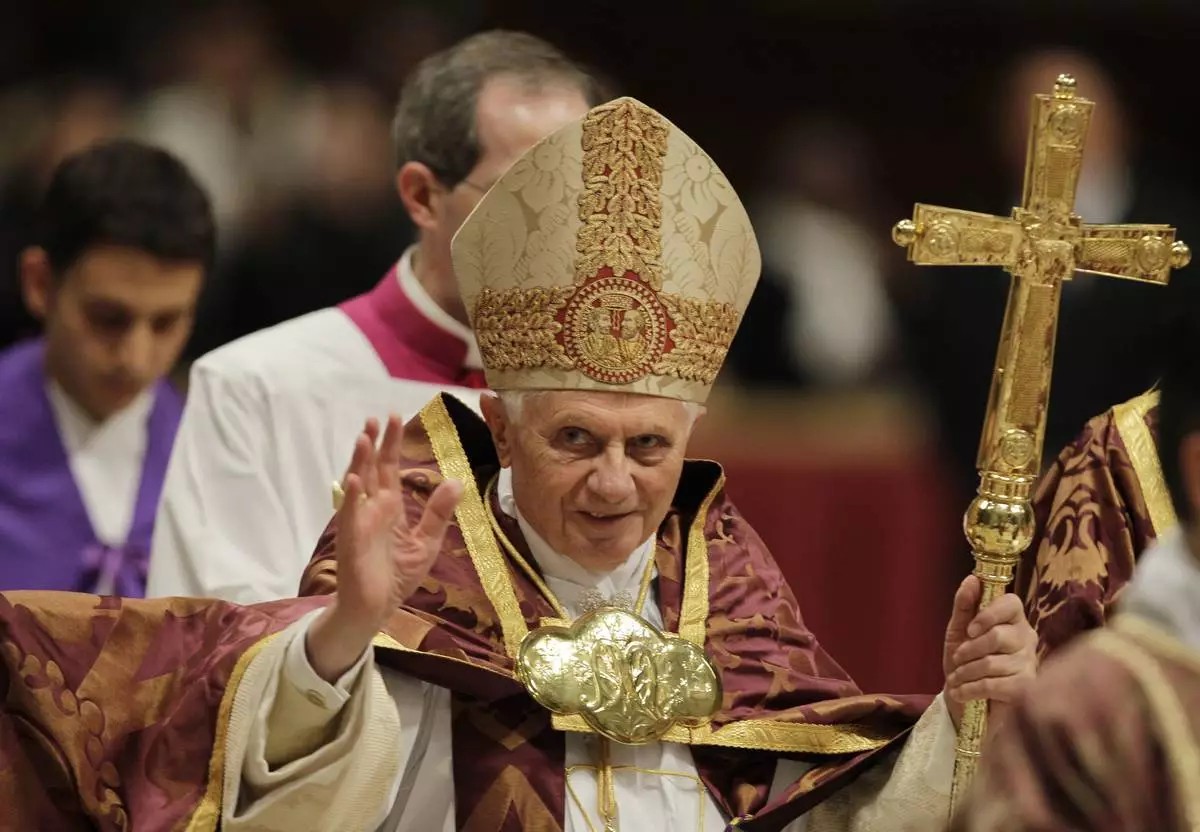
FILE - Pope Benedict XVI blesses the faithful as he arrives at St. Peter's Basilica in the Vatican, Dec. 16, 2010. (AP Photo/Alessandra Tarantino, File)
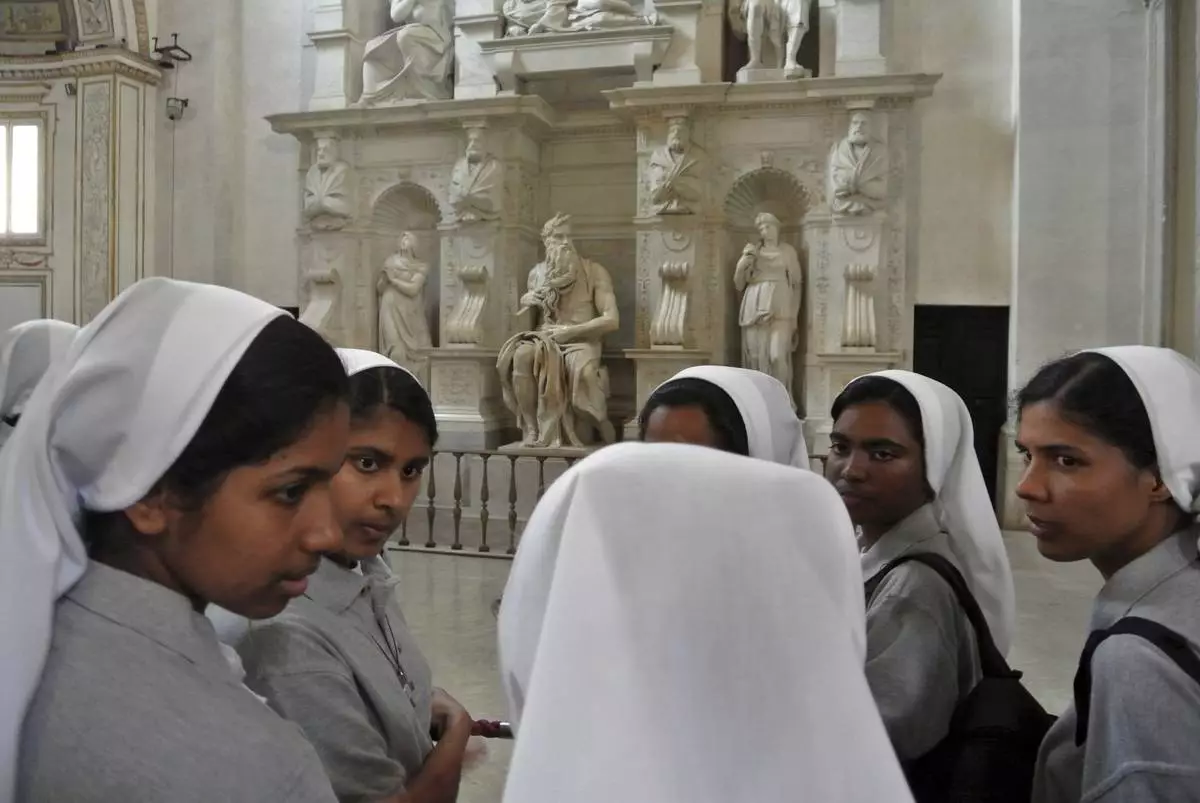
FILE - Nuns talk in front of Italian Renaissance artist Michelangelo Buonarroti's Moses statue, part of a funerary monument he designed for Pope Julius II inside San Pietro in Vincoli Basilica in Rome, July 2, 2013. (AP Photo/Gregorio Borgia, File)
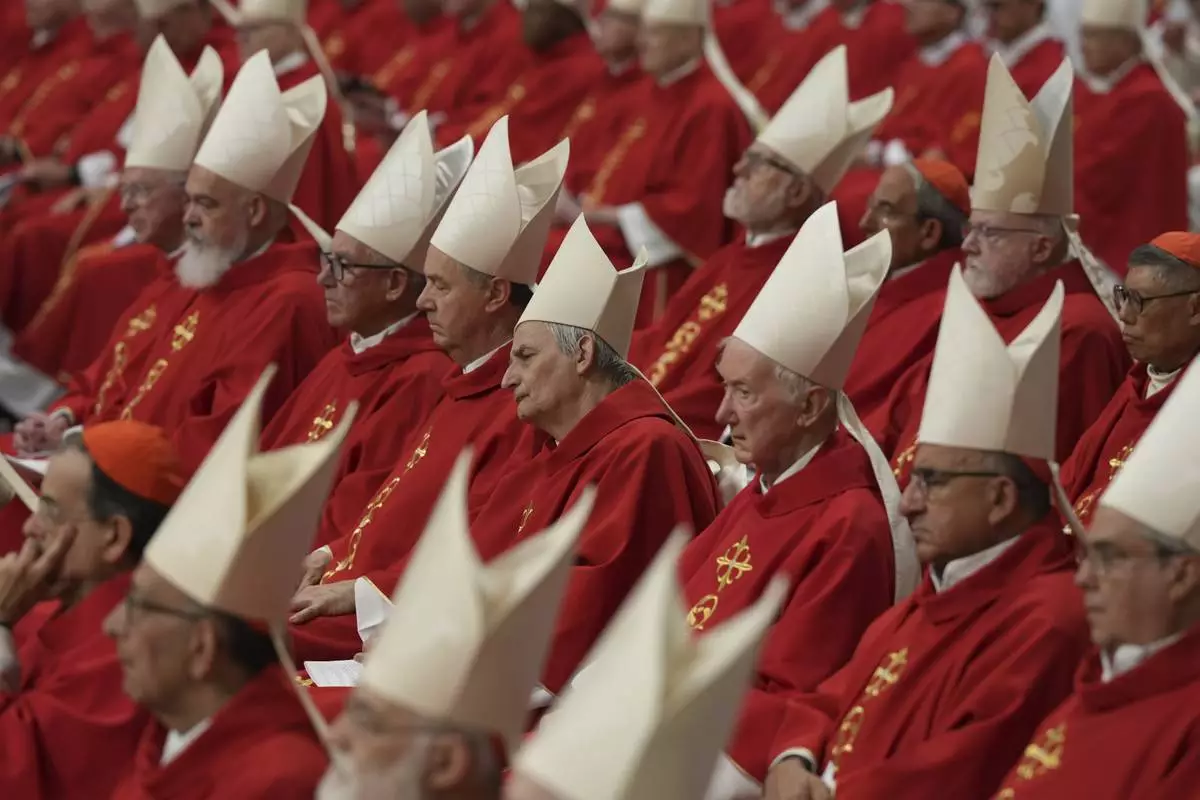
Cardinal Matteo Zuppi, centre, attends a mass on the third of nine days of mourning for late Pope Francis, in St. Peter's Basilica at the Vatican, Monday, April 28, 2025. (AP Photo/Andrew Medichini)
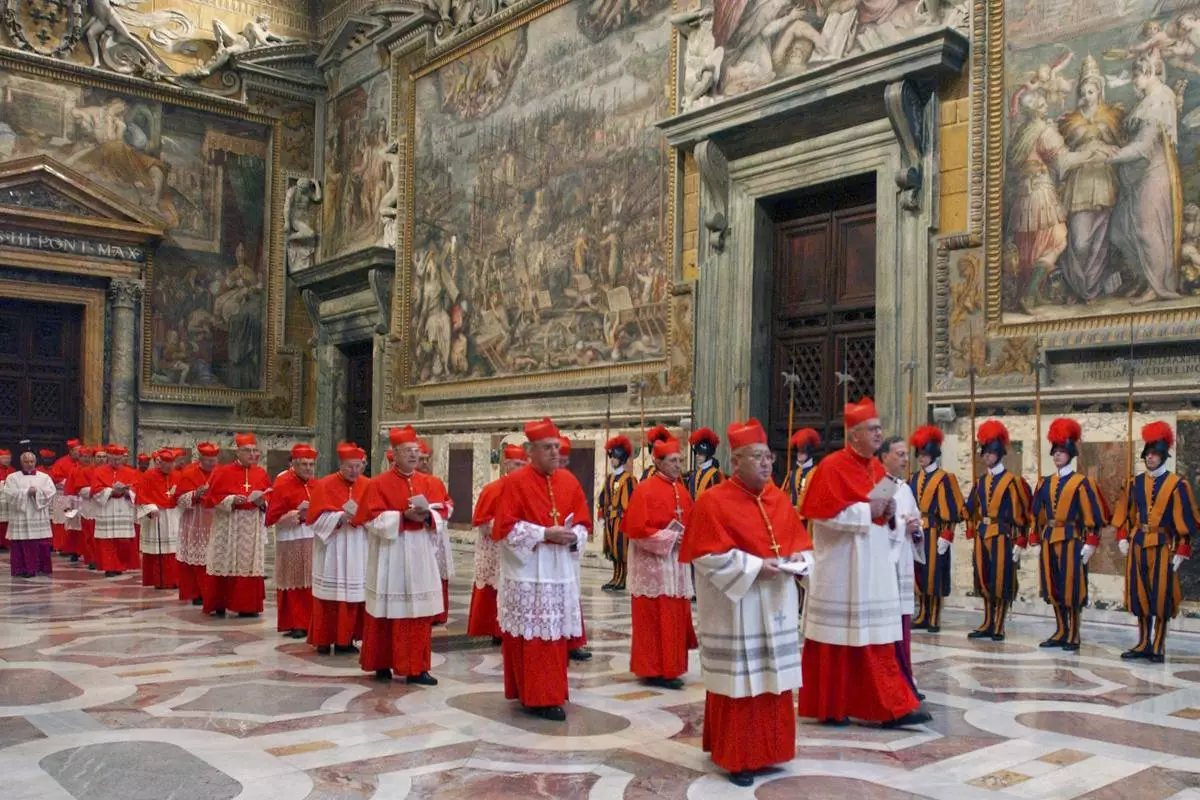
FILE - Cardinals walk in procession to the Sistine Chapel at the Vatican, at the beginning of the conclave, April 18, 2005. (Osservatore Romano via AP, File)

































